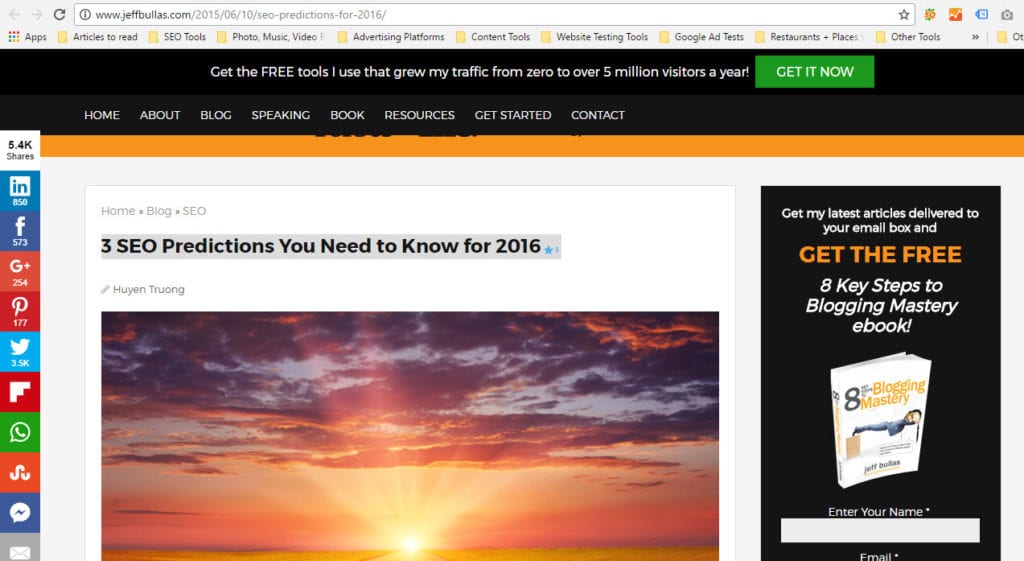Hi, I'm Huyen
Our work (and this site) is devoted to sharing ideas, tools and resources that will help you automate, grow and scale your practice.
Do you know that?
“Small to medium sized medical practices with a regularly updated blog get 120% more lead growth than those who don’t.”
And also “B2B marketers that use blogs receive 67% more leads than those that do not.” (Stats: Hubspot)
Blogging or producing valuable content is undoubtedly a great tool to compete with your giant competitors who has huge budget for paid media, which is usually not in your list of promotional avenues.
Throughout my years of experience, I’ve noticed there are certain types of content that helps you boost traffic, gain more backlinks (people linking back to your site), thus better for your site rankings and drive conversion.
Let me walk you through this list:
CONTENT TYPE #1: INFOGRAPHICS
An infographic is the presentation of information or data visually. Infographics get shared more, viewed more and loved more than most other content.
If a picture paints a thousand words, it just makes sense to use a picture if you have massive amounts of data to represent.
I created a simple infographic about "8 SEO Tips To Grow Your Small Business" a while ago and this one has brought in quite a few quality backlinks, which is awesome for my website ranking.
People use this infographic on their sites and link back to Result Driven SEO to give my site some credit. It was even shared on some Spanish and French blogs.
Here is one example: http://www.crmwebnews.it/8-strategie-seo-per-il-tuo-business/
THINGS TO KEEP IN MIND
While an infographic might be expensive—for example, the one above cost $350—they are effective. However, whereas once upon a time an infographic was virtually assured of going viral by virtue of the mere fact that it was an infographic, that’s not so true today.
These days infographics must be of a high standard to be popular.
Infographics are not the only way to visually represent data. You can also use graphs, maps or gifographics. A gifographic features very short, repetitive animated pictures, instead of a static image.
CONTENT TYPE #2 VIDEOS: GOOD VIDEOS COMMUNICATE WELL
A good video communicates your message clearly, simply and concisely on two levels.
It’s great if you wish to illustrate to your target audience how your product or service works. And it’s equally important to engender trust.
Some people don’t like reading, so make it easy for them by offering content in the form of a video. It has the added advantage of creating a human connection to your practice.
THINGS TO KEEP IN MIND
Producing a good video is not cheap and there’s a reason for this. It requires writing a script, and expensive lighting and microphones, so even the shortest video has a high production cost that usually exceeds $1,500.
For this reason videographers may try to upsell you into longer videos. Resist this. If the video is being viewed online, you only have a 30 second to 2 minute (at the most), window of opportunity before most viewers lose interest.
A more effective strategy is to either do it in house or find a medical practice that specialises in producing 90-second corporate YouTube clips for less than $1,500.
CONTENT TYPE #3: OPINION POSTS
Everyone loves controversial posts that forecasts trends, dives deeply into new angles or provides high-level breakdowns.
The business-to-business world is no different. Trouble is, 90% of the content delivered as part of the corporate content marketing strategy is unworthy of being published. If it was submitted to a real editor, it would be immediately filed in the rubbish bin or trash.
You can’t just continue to regurgitate or plagiarise someone else’s blog post and expect it to deliver the same results as an original opinion based on robust experience. Remember the pull strategy.
People prefer controversial content. If you say something that’s unexpected or counter intuitive, you immediately grab someone’s attention and it has a huge follow-on effect with people reading it, commenting on it and often sharing it whether they agree or disagree with the stated opinion.
This is because it invokes strong emotion—surprise, empathy or even anger.

Image 2: Emotion Inspired By Different Type Of Content Via Buffer
THINGS TO KEEP IN MIND
Don’t confuse having a strong opinion with ranting. Constantly getting up on your soapbox and going on and on about your favourite topic is obnoxious, so go there at your own risk.
Be respectful. Don’t make personal comments. Try to present both sides of the argument even if you are one-eyed about it.
But most of all, write with clarity and humility. This is your opinion. The world is a big place. It’s likely someone else will know more than you, so write accordingly.
CONTENT TYPE #4: PREDICTION, FORECAST ARTICLES ABOUT WHAT’S HAPPENING NEXT
People tend to be curious and have a desire to know about the future. If you have something to predict, go for it. It’s a surefire way to generate tons of shares on social media.
I wrote this article about “Three SEO predictions you need to know for 2016” a few months ago and it immediately got more than 1,000 Tweets the night after it went live.
It has now been shared all over the web and has the all time high record of almost 5,000 shares across all different platforms.

Image 3: The article has now been syndicated on many digital marketing highly authoritative sites including Yahoo Small Business.
CONTENT TYPE #5: HOW-TO ARTICLES
“How-to” and “How-do-I” stories are amongst the most popular types of content and they have amazing long tail keyword search potential.
These types of stories can range from simple step-by-step instructions, to a complete guide.
How do you write a ‘How-to’ story?
- Identify a common problem
- Identify the “benefits” of a solution
- List the steps to achieve the solution
- Write a ‘wrap up’ or summary that includes additional helpful information or insights.
THINGS TO KEEP IN MIND
Getting started on a ‘how-to’ is probably the hardest part.
If you can’t think of a topic personally, do some long-tail keyword research to identify popular search topics in your industry, or informally survey your patients or website visitors on their pain points.
It could be industry specific or more general such as, “laser eye bag removal?,” or “How to remove eye bag without surgery”
Provide a thorough explanation that uses diagrams, videos and pictures to demonstrate your solution.
CONTENT TYPE #6: PRODUCT REVIEWS
Every industry has its own products, software and services. When you review key developers, manufacturers, or service providers, you gain recognition and respect. It requires you sharing your product experience and providing your recommendation.
How do you write a “product review?”
- Introduce the product and manufacturer
- Describe the product, its functionality and application
- List the best and worst attributes
- Provide your recommendation
- Provide a call to action
THINGS TO KEEP IN MIND
Consider using video to illustrate the hands-on parts of the product.
CONTENT TYPE #7: CASE STUDIES
A case study explains what your practice service is and how it helps a patient. In short it covers, “what we did, how we did it, and the results we got.”
Case studies, also referred to as ‘war stories’, which are probably the hardest working type of content when it comes to converting leads.
They demonstrate that your service can work, and they tend to engender a feeling of trust, especially if they include ‘warts and all’ about what did and did not go well.
Trust is considered the most important factor in conversion rate optimisation.
How do you write a great case study?
- The situation you are writing about in the headline.
- Mention the results achieved in the first paragraph
- Quantify the actual results if possible
- Ensure the first paragraph is 30 words or less
- Case studies do not suit everyone. If there is no clear value that’s been achieved there’s little point writing about it.
However, if your potential patients harbour any uncertainty about your services—will it work, will it work how I want it to, can I trust the medical practice—case studies do a good job of clarifying the benefits.
THINGS TO KEEP IN MIND
- Write your case study from an independent view so it does not sound like a glossy advertisement.
- Make it a story. Keep it interesting. Include some emotion.
CONTENT TYPE #8: EBOOKS
An ebook is long content packaged in a different format, usually as a PDF. Ebooks are often a free downloadable product that is exchanged for an email address.
Producing an ebook helps to strengthen your authority and is a great way to share your knowledge with others.
How do I write an ebook?
- Consider bundling up several blog posts to create an ebook. Ten thousand words is a good target.
- Divide the ebook’s content into intuitive topic-oriented chapters.
Image 4: Example of an eBook/complete guide that I wrote specifically for healthcare practitioners to grow their practices online. You can get a copy here.
THINGS TO KEEP IN MIND
A good ebook has a great title. Spend time on brainstorming and selecting a powerful title.
Just because it’s an ebook is no reason to skimp on design.
Ebooks without appealing colours, graphics and formatting are not going to achieve the results you are seeking.
Create both a PDF and HTML version of the ebook so you have the opportunity to embed video and audio.
CONTENT TYPE #9: GUIDES
A guide is a detailed and fairly long piece of content. It goes beyond the length, style and approach of an ordinary blog post.
Whereas you can probably get away with writing some of your own content, it represents good value for money to employ the services of a good writer and designer for this type of content.
More importantly, the guide needs to fulfil a need of your target patient base. Remember the ‘pull campaign’ theory.
THINGS TO KEEP IN MIND
- A guide needs to look good and read well.
- It’s usually in the form of a PDF
- Guides can be used to harvest email addresses—to get your free guide register here with your email address.
CONTENT TYPE #10 PODCASTS:
Podcasts had their phase of popularity, and they’re still a great form of content. Plus, they’re not hard to create.
Many people listen to podcasts during their commute or exercise. This format spreads your message further and better than a lot of other formats.
Creating a podcast, like a video, requires a good quality microphone and some technical knowledge. Check out Apple’s guide here. [http://www.apple.com/au/itunes/podcasts/specs.html]
THINGS TO KEEP IN MIND
Actually creating the podcast is only the start of this type of content. The real work comes after it’s created. It’s release then needs to be touted about in your regular blog and shared on social media. And if you have the resources you could even publish its transcript, which really boosts SEO.
CONTENT TYPE #11 LISTS:
Checklists, resource lists, lists of lists, news lists and demonstrations are always popular forms of content.
George Loewenstein’s, The Psychology Of Curiosity: A Review And Reinterpretation says that humans are basically lazy and when faced with a choice of searching through millions of Google results or getting a list of tips and insights, we’ll chose a list every time.
THINGS TO KEEP IN MIND
- Consider using an old journalist trick that combines a number with an adjective to create a more powerful headline. For example, this story is titled, 13 VITAL types of content that boost SEO like crazy, not 13 types of content that boost SEO like crazy.
- Create odd-numbered lists. Instruction specialist, Abreena Tompkins, [http://www.facultyfocus.com/articles/online-education/brain-based-online-learning-design/] claims that breaking down chunks of information into odd-numbered batches, helps the brain process information in manageable groups.
CONTENT TYPE #12: INTERVIEWS:
There are two types of interviews. The discovery interview is where you interview a person to discover more about them or their field of expertise. Apart from maybe one of two set questions, it generally doesn’t follow any other formula.
Rather it meanders along a path that’s created by asking about the most interesting interviewee’s comments.
Another type of interview is the question and answer interview. This is generally done by writing out a list of questions, submitting them to your interviewee and publishing their returned answers.
This type of interview has its advantages. It’s less time consuming and has an easier approval process because the interviewee usually writes the answers.
However it is a poor cousin to the entertainment or information value of the discovery interview.
How do you conduct an interview? Introduce the interviewee by name and establish their credibility by providing a brief background of their experience.
Ask two or three set open-ended questions designed to get straight to the nub of ‘the good stuff’ then allow the discussion to drive itself by following up on only the most interesting snippets of information.
If you are genuinely interested in what the interviewee has to say, you can be guaranteed your audience will remain riveted as well.
THINGS TO KEEP IN MIND
- Consider providing a transcript of the interview to a medical practice: an audio or a video.
CONTENT TYPE #13: RESEARCH AND ORIGINAL DATA:
Sharing your findings with others is a powerful way to drive traffic, build trust, and establish your authority.
When you do the research, which is hard work, people respect that. What’s more, it gets shared prolifically.
Generating this type of content can be time consuming. A popular and effective way is to use survey software to formally mine information from a large pool of respondents.
Present the information in an engaging way using graphics, real numbers and percentages to highlight trends, similarities and unexpected differences.
THINGS TO KEEP IN MIND
- Professionally conducted research is expensive
- An alternative is to use the type of information you mine every day for your own practice, such as most clicked content, or longest-viewing web pages, and present this information as your research.
- Use graphics, infographics and even video blogs to present your information in a more compelling manner.
- Include your conclusions.
THE BOTTOM LINE?
So now it’s your turn. We have addressed what we set out to address. Is this the sort of information you need to build your practice and the sort of information you want to ‘pull’ down from us?
If so leave a comment. If not, let me know and we’ll try to write about what you want next time.
Hi, I'm Huyen
Our work (and this site) is devoted to sharing ideas, tools and resources that will help you automate, grow and scale your practice.
YOU MAY ALSO LIKE...
Featured Content
Categories











